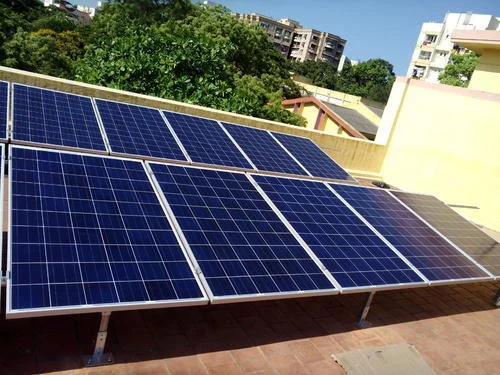3KW Solar Power System
3kW Solar Power System
In a world where energy bills seem to rise as steadily as the sun itself, there’s a bright and sustainable solution – a 3kW solar power system. Whether you’re a homeowner looking to trim your electricity costs or a business aiming for a greener approach, these solar systems hold the key. In this article, we’ll introduce you to 3kW solar panels. We’ll demystify workings, explore benefits, discuss pricing, and even delve into the enticing government incentives that can make your transition to solar energy not only environmentally friendly but cost-effective, too.
Understanding the Working of a 3kW Solar Power System
A 3kW solar power system is an efficient and sustainable energy solution, ideal for small to medium-sized households or businesses with moderate energy needs. It typically consists of 8–12 photovoltaic (PV) panels that capture sunlight and convert it into electricity, an inverter to transform the direct current (DC) from the panels into alternating current (AC) for household use, a mounting structure for secure installation, and optionally, a battery for storing excess energy. This system generates approximately 12–15 kWh of electricity per day, depending on factors like location, panel orientation, and weather conditions. The generated electricity is used to power household appliances, with any surplus stored in a battery or fed back into the grid.
The efficiency of a 3kW solar system is influenced by factors such as sunlight availability, proper panel orientation, and local weather conditions. Installation typically requires around 20–30 square meters of roof space, and professional setup ensures optimal performance and compliance with regulations. A well-maintained system can last over 20–25 years, requiring minimal maintenance, such as periodic cleaning of the panels and regular checks on the inverter. By reducing electricity bills, lowering carbon emissions, and decreasing reliance on the grid, a 3kW solar power system offers significant cost savings, environmental benefits, and energy independence.
Enquiry Form
Why Choose a 3kW Solar Power Plant?
- Optimal for Homes: Powers essential appliances like lights, fans, TVs, and refrigerators efficiently.
- Cost-Effective:Significant savings on your monthly electricity bills.
- Eco-Friendly:Reduce your carbon footprint by switching to clean solar energy.
- High Efficiency:Built with state-of-the-art technology for maximum energy conversion.
Maintenance and Long-Term Considerations
A 3kW solar power system requires minimal maintenance, but regular attention is crucial to ensure optimal performance and longevity. Basic tasks include cleaning the solar panels periodically to remove dirt, dust, and debris that may obstruct sunlight and reduce energy production. Additionally, the inverter should be checked for any signs of wear or malfunction, as it typically needs to be replaced every 10–15 years, while the solar panels can last 20–25 years with proper care. Regular inspections of wiring and connections are also important to ensure everything is functioning properly.
Over time, the system’s energy output may decrease slightly due to panel degradation, but maintaining the system and monitoring its performance through an app or monitoring system can help identify any issues early. Long-term considerations include potential upgrades, such as adding more panels for increased capacity or incorporating battery storage to enhance energy independence. By performing routine maintenance and planning for future improvements, homeowners can ensure that their solar system continues to provide reliable, cost-effective power for decades.
3kW Solar Panel Price in India with Subsidy
A 3kW solar system is an optimal option for those who want to reduce costs of electricity and switch to an environmentally friendly solution. The 3kW Solar System Price in India With Subsidy is determined by such things as the type of solar panel and location for installation. The cost on average is within the range of ₹2.30 lakh to ₹2.50 lakh. Meanwhile, thanks to the Government providing the financial aid under programs such as PM Surya Ghar Yojana one can reduce the cost by approximately ₹78,000.
Therefore, solar energy is getting more acceptable and affordable for the residents. Such a 3kW solar system usually produces 12-15 units of electricity a day, thus greatly lowering power bills. Additionally, this equipment also moves in the direction of India’s green energy implementation and is one of the sources of sustainable growth. By choosing a subsidized solar system, you make the first step to achieve stable and efficient energy supply and enjoy economic advantages as well.
Government Subsidies and Incentives
1kw solar systems to 10kw panels are eligible for solar subsidy in India. India offers several incentives to encourage the adoption of solar power. The government provides financial incentives at the central level, like the ‘Grid-Connected Rooftop Solar Power Plant’ scheme, which offers financial support for solar installations. However, at the end of 2022, the government introduced and implemented the Rooftop Solar Programme Phase II, in which residential consumers can avail financial assistance from the central government for installing rooftop solar panels.
Furthermore, residential and commercial users are eligible for tax deductions on the interest paid on a loan for the solar system. Additionally, net metering allows consumers to sell excess electricity back to the grid. This system helps in restoring the excess power that can be used when the solar plants aren’t functioning.
Your Solar Journey Starts Here
Empowering your solar journey begins with a single step—choosing to go solar. Let Shri Solar guide you every step of the way as you transition to a brighter, cleaner, and more sustainable energy future.
3KW Solar Pannels





